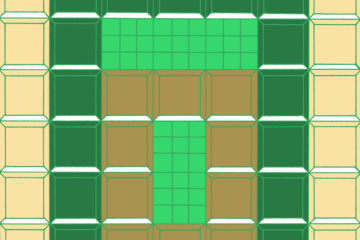Geometry is IN . . . Five Cents Please.
 Like Lucy in the Peanuts strip, here’s a nickel’s worth of free advice on geometry: Watch out for the football!
Like Lucy in the Peanuts strip, here’s a nickel’s worth of free advice on geometry: Watch out for the football!
Geometric patterns can be endlessly intriguing. Like a mandala (the Hindu symbol representing the universe), a Japanese zen garden, or a Mayan temple, geometric designs speak a universal language, so they are worth perfecting. They fascinate, give the eye somewhere to go, and reveal hidden meanings when you see something that wasn’t obvious the first time.
What is the secret to perfecting your geometric designs? Fortunately for us creative-types, the answer does not lie in a math book. The right geometric pattern depends on balancing all the colors and lines with the overall image and can last for years without becoming a bore. The key, therefore is balance. But balance can be a complicated concept, relying on the perception of the viewer for its success. Let’s stick to the basics: symmetry, asymmetry, and radial balance.
Symmetry is the easy one — take what you’ve done and repeat it exactly up, down, left or right and you have symmetry. The balance here comes from predicting, and finding, the pattern. When Lucy puts both elbows on the counter and holds her head in her hands, that’s symmetry because you could put a mirror in the middle and see the other side of Lucy exactly as it is drawn.
Now for the tough one! Asymmetric means there is no symmetry (exact repetition), so balance is achieved by manipulating images off-center on the page. For example, one large object on one half of the page could be balanced with several small objects on the other half. Then again, one large object could be balanced with another large object, neither of which are mirror images. A good rule of thumb when working with seemingly random patterns like those in asymmetry is to make sure that your eye travels all over the page — if it get’s stuck somewhere, you don’t have the right balance. Think of Lucy sitting with her feet up in the psychiatry booth. Your eye travels up and down between 3 boxes — the drawing of Lucy in the middle, the name of Lucy’s booth at the top, and the “Doctor Is In” sign at the bottom.
Radial balance means all the objects on the page emanate from a central point. When the objects are tied to this point, the eye easily puts everything in order and has no difficulty moving about the page. A center point inside of multiple circles is radial symmetry. Radial asymmetry,however, is a little harder — just think of Lucy’s football. When the action happens and she whisks away the ball, Charlie Brown flies through the air in an asymmetric radial pattern. The central point is the football, Charlie Brown is rotating around it and Lucy off-sets his shape on the page.

